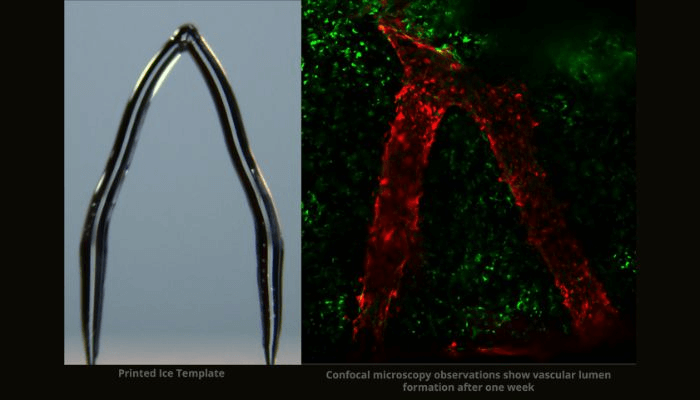
As the need for organ donation, especially for hearts, kidneys and livers, becomes more widespread, more and more scientists are devoting themselves to finding ways to create viable artificial organs, although there has been little success in recent years. Now, however, there may be a solution. Researchers at Carnegie Mellon University have shown that they have found a way to bridge the gap between available organs and the demand for transplants. Using 3D printing of ice, they discovered that it is possible to create structures that resemble blood vessels, mimicking their natural design and allowing them to function properly in the body.
According to the Division of Transplantation (DoT), the federal agency responsible for overseeing the organ and blood stem cell transplant systems in the US, there were 103,223 men, women and children on the national waiting list in 2024 for transplantation. In addition, the number is constantly growing, with a new person added every 8 minutes.

Many on the organ transplant list have long waiting times, particularly for organs where demand is high, such as kidneys (Image: HRSA)
Not only that, but the DoT estimates that around 17 people die every day waiting for organ transplants, over 6,000 per year. This is why so much time and research has been devoted not only to increasing the number of organ donors (to an estimated 170 million people in the US by 2022, although it should be noted that not everyone who registers as a donor can to actually donate) , but also finding alternative ways to obtain viable organs. Here, a lot of hope is placed on methods such as 3D printing.
Indeed, although much work has gone into techniques such as bioprinting, there are persistent obstacles to creating lab-grown organs. Most notably, it is a huge challenge to create networks of blood vessels in artificial organs that work like natural ones. In general, traditional artificial blood vessel designs are unable to mimic natural ones and therefore cannot function properly. Now, 3D printing ice could be the answer.
3D printing of ice used to create artificial blood vessels
Above, we told you about 3D printing of ice , originally developed by engineering researchers at Carnegie Mellon in 2022. The process usually involves adding a stream of water to a very cold surface. The water in question is "heavy water," meaning that the hydrogen atoms in the water have been replaced with deuterium, which gives the water a higher freezing point and helps create a smooth texture. As you might expect, the part is made by freezing the water layer by layer.
Feimo Yang, a graduate student in the labs of Philip LeDuc and Burak Ozdoganlar at Carnegie Mellon University who led this research, further explained how ice 3D printing differs from other processes: “ What makes our method different from other types of 3D printing is that instead of letting the water freeze completely while we print, we let it maintain a liquid phase on top. This continuous process, which we call free form, helps us to obtain a very smooth structure. We don't have the layering effect typical of a lot of 3D printing."

Images: Feimo Yang
Once the 3D printed ice templates are ready, they are embedded in a gelatin material, GelMA. This is exposed to ultraviolet light, which makes the gelatin harden and melts the ice. The result is then realistic blood vessel channels.
And it was relatively successful, as the researcher was able to demonstrate that he could introduce endothelial cells, which line all blood vessels and regulate the exchange between blood flow and surrounding tissue, into these manufactured blood vessels. The cells survived on the gelatin for up to two weeks, and the researchers now intend to culture the cells for a longer period of time.
In addition to organ transplants, this research could also be ideal for testing the effects of drugs on blood vessels. And they are certainly a big step forward in creating complex, realistic networks of blood vessels for tissue engineering, and perhaps a major breakthrough in the creation of artificial organs.
0 Comments